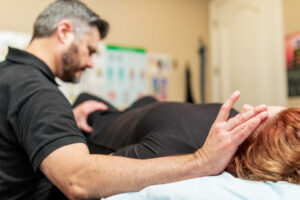 Craniosacral therapy is a gentle, hands-on treatment approach. Designed to restore and maintain whole-body health, it uses the body’s own monitoring system, the central nervous system (CNS), to detect and resolve whatever imbalances the body considers the most significant. The CNS consists of the brain and spinal cord.
Craniosacral therapy is a gentle, hands-on treatment approach. Designed to restore and maintain whole-body health, it uses the body’s own monitoring system, the central nervous system (CNS), to detect and resolve whatever imbalances the body considers the most significant. The CNS consists of the brain and spinal cord.
It is through the CNS that the internal environment of the entire body is monitored and maintained. Every cell in our entire body is already programmed with detailed information regarding how to carry out its own tasks but requires specific conditions to do so. Each cell continuously sends information about its local environment to the CNS.
To maintain the optimal environment for the entire body, the CNS interprets all of this information and sends back instructions to the cells to carry on or change. While we strive to develop instruments to understand what is happening within our bodies, the CNS is far more sophisticated, accurate, and current than any external monitoring system we could invent. The craniosacral therapy approach is to use this system to determine what is creating a state of imbalance within a person, then provide support until it balances.
To understand the method we use to monitor the CNS, we first need to understand how fluid moves around the brain and spinal cord. A series of membranes surrounding the brain and spinal cord called the meninges contain a specialized fluid called  cerebrospinal fluid, or CSF, which suspends and continuously bathes the CNS. CSF offers physical protection, removes waste, and provides the necessary environment for the CNS to carry out its unique metabolic, chemical, and electrical processes.
cerebrospinal fluid, or CSF, which suspends and continuously bathes the CNS. CSF offers physical protection, removes waste, and provides the necessary environment for the CNS to carry out its unique metabolic, chemical, and electrical processes.
CSF is produced from the filtration of blood by specialized cells that envelope every blood vessel within the CNS. CSF is absorbed from the CNS by these specialized cells and returns to the bloodstream as it leaves the CNS. The drainage of CSF is more constant than its production.
As CSF volume decreases, the pressure within the meninges falls, stimulating an increase in CSF production. As the volume of CSF increases, the pressure within the meninges rises, stimulating a reduction in CSF production. This ebb and flow of CSF volume and pressure within the CNS create the craniosacral rhythm.
With enough sensitivity and training, we can monitor this rhythm and its effects throughout the entire body.  The craniosacral rhythm is in the range of around 6-12 cycles per minute. To put that in perspective, the typical respiratory rate is in the range of about 15-18 breaths per minute. The typical heart rate is in the general range of 60-80 beats per minute.
The craniosacral rhythm is in the range of around 6-12 cycles per minute. To put that in perspective, the typical respiratory rate is in the range of about 15-18 breaths per minute. The typical heart rate is in the general range of 60-80 beats per minute.
Detecting the craniosacral rhythm requires a lot of sensitivity, much more than required to detect a heartbeat. Often the craniosacral rhythm will suddenly, briefly stop, sometimes for a second or several minutes. We refer to this moment as a “still point.”
We think this must be some type of system resetting, similar to how a computer reboots when newly installed updates need to be implemented. Whenever we detect a still point, we believe that something of significance must be occurring within the body to trigger the CNS to reset. By engaging the body with our hands, we can identify what the body is doing during a still point.
 This allows us to know exactly how to support the body with our hands and help it resolve the most significant conflicts. As the conflicts resolve and barriers are released, the person progressively moves toward a greater state of balance and harmony. William Garner Sutherland, DO (1873-1954) was the first to document the discovery of a palpable but rhythmical cranial motion.
This allows us to know exactly how to support the body with our hands and help it resolve the most significant conflicts. As the conflicts resolve and barriers are released, the person progressively moves toward a greater state of balance and harmony. William Garner Sutherland, DO (1873-1954) was the first to document the discovery of a palpable but rhythmical cranial motion.
This discovery ultimately led to his development and teaching of a treatment approach using this system in the early and mid-1900s, which he ultimately called “The Primary Respiratory Mechanism.” John Upledger, DO (1932 – 2012) discovered the craniosacral rhythm by accident while assisting in surgery to remove plaque from the outer meningeal membrane, which we call the dura. During the 1970s and 1980s, he researched and developed the concept and treatment curriculum that he eventually called craniosacral therapy.
He started the Upledger Institute in 1985, which has since expanded and developed many other teaching curriculums. For more information on the Upledger Institute, visit www.upledger.com, where you can also access a list of local practitioners who have taken any courses within the International Alliance of Healthcare Educators by simply clicking on the tab at the top of the page for “Find a Therapist,” then click the box for “Find a Practitioner,” then enter your search by location, practitioner name, or modality of practice.
